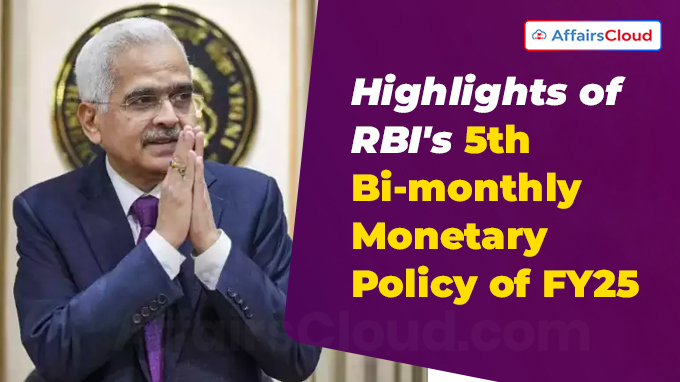 The Reserve Bank of India’s (RBI) Monetary Policy Committee (MPC) met from 4th December to 6th December 2024 and released its 5th Bi-Monthly Monetary Policy of Financial Year 2024-25 (FY25). The six-member rate-setting panel has revised India’s FY25 Gross Domestic Product (GDP) growth forecast down to 6.6% from the previous projection of 7.2% for FY25. The December FY25 meeting was RBI’s 52nd MPC meeting.
The Reserve Bank of India’s (RBI) Monetary Policy Committee (MPC) met from 4th December to 6th December 2024 and released its 5th Bi-Monthly Monetary Policy of Financial Year 2024-25 (FY25). The six-member rate-setting panel has revised India’s FY25 Gross Domestic Product (GDP) growth forecast down to 6.6% from the previous projection of 7.2% for FY25. The December FY25 meeting was RBI’s 52nd MPC meeting.
- RBI has projected the real GDP growth for 2024-25 with Q3 at 6.8% and Q4 at 7.2%. Real GDP growth for Q1:2025-26 is projected at 6.9%; and Q2 at 7.3%.
- The repo rate under the Liquidity Adjustment Facility (LAF) was kept unchanged at 6.50% for the 11th consecutive time with a 4 to 2 majority. Saugata Bhattacharya, Rajiv Ranjan, Michael Debabrata Patra and Shaktikanta Das voted to keep the policy repo rate unchanged at 6.50%. Nagesh Kumar and Ram Singh voted to reduce the policy repo rate by 25 basis points.
- The MPC also decided to continue with the neutral monetary policy stance and to remain unambiguously focused on a durable alignment of inflation with the target, while supporting growth.
Note
The next meeting of the MPC is scheduled during 5th to 7th February 2025.
RBI’s Policy Rates:
| Category | Rate |
|---|---|
| Policy Repo Rate | 6.5% |
| Fixed Reverse Repo Rate | 3.35% |
| Standing Deposit Facility (SDF)Rate | 6.25% |
| Marginal Standing Facility (MSF) Rate | 6.75% |
| Bank Rate | 6.75% |
| Cash Reserve Ratio (CRR) | 4.0% |
| Statutory Liquidity Ratio (SLR) | 18% |
RBI raises FY25 inflation estimate to 4.8%, CPI to remain elevated in Q3
i.The RBI has raised the inflation forecast for FY25 to 4.8% as against 4.5% earlier with Q3 at 5.7% and Q4 at 4.5%.
- CPI inflation for Q1:2025-26 is projected at 4.6%; and Q2 at 4.0%.
- According to RBI, the risks are evenly balanced.
ii. RBI has set a target for CPI inflation of 4% within a band of +/- 2%.
iii.Headline CPI inflation surged above the upper tolerance level to 6.2 % in October 2024 from 5.5% in September due to rise in food inflation and core (CPI excluding food and fuel) inflation.
- However, RBI expects food price pressures to keep headline inflation elevated in the December quarter as well.
- The estimates of a record kharif production is expected to bring relief to the elevated prices of rice and tur dal and vegetable prices are also expected to see a cool down.
RBI allows SFBs to offer pre-sanctioned credit lines on UPI
i.The RBI has permitted small finance banks (SFBs) to offer pre-sanctioned credit lines via the Unified Payments Interface (UPI).
- This facility previously available only through scheduled commercial banks.
ii.This move will provide support underserved groups, including small businesses, micro-entrepreneurs, and individuals in rural and semi-urban regions.
iii.By linking pre-sanctioned credit lines to UPI, users can easily access overdrafts, retail loans, and credit lines for transactions, fostering economic growth.
Note: The pre-sanctioned credit line limit on the Unified Payments Interface (UPI) is between Rs 25,000 and Rs 5 lakh.
RBI reduces CRR to 4% to ease anticipated liquidity stress
i.The Reserve Bank of India (RBI) has reduced the cash reserve ratio (CRR) of all banks by 50 basis points in two equal tranches of 25 bps each to 4.0% of their deposits.
- This reduction will release primary liquidity of about Rs.1.16 lakh crore to the banking system.
ii.This is aimed at reducing the expected liquidity tightness towards mid-December, when Goods and Services Tax (GST) and advance tax outflows will happen.
iii.The two-tranche CRR cut is with effect from the 14th December, 2024 and 28th December 2024, respectively.
- This will also restore the CRR to 4% of net demand and time liabilities (NDTL), which was prevailing before the start of the policy tightening cycle in April 2022.
RBI increases collateral free loan limit for farmers from Rs 1.6 lakh to Rs 2 lakh
i.RBI has decided to increase the limit for collateral free agricultural loans from Rs 1.6 lakh per borrower to Rs 2 lakh per borrower keeping into account the rise in agricultural input costs and overall inflation
- At present, banks are required to extend collateral-free agriculture loans up to Rs 1.6 lakh per borrower. This limit was enhanced from Rs 1 lakh, set in the year 2010 to Rs 1.6 lakh in the year 2019.
ii.This will enhance coverage of small and marginal farmers in the formal credit system.
RBI allows higher interest rates on FCNR deposits
i.RBI has decided to increase the interest rate ceilings on foreign currency non-resident (banks) account, or FCNR(B), deposits to support foreign inflows into the country as the domestic currency is facing devaluation pressures against the United States (US) dollar.
- RBI increased the interest rate ceilings on FCNR(B) deposits of 1-5 years’ maturity by up to 150 basis points (bps).
- Banks can now raise these deposits at the overnight alternative reference (ARR) plus 400 bps for deposits of 1-3 years, and at ARR plus 500 bps for deposits of 3-5 years. This relaxation by the RBI is available till 31st March, 2025.
ii.Earlier, rates on FCNR(B) deposits had ceilings of overnight ARR for the respective currency/swap, plus 250 bps for deposits of 1-3 years and overnight ARR plus 350 bps for deposits of 3-5 years.
Note
According to latest RBI data, during April-September 2024, about USD 5.34 billion flowed into FCNR(B) accounts, compared to USD 1.92 billion in the corresponding period a year ago. The outstanding amount in FCNR(B) accounts stood at USD 31.08 billion.
About foreign currency non-resident (banks) account FCNR (B)
FCNR (B) is a deposit scheme that allows non-resident Indians (NRIs), persons of Indian origin (PIOs) and overseas citizens of India (OCIs) to invest their foreign earnings in Indian fixed deposit accounts.
- Such deposits can be made in multiple currencies such as US dollar, British pound sterling, Australian dollars, euros and Canadian dollars.
RBI unveils MuleHunter to prevent digital frauds
i.The RBI has launched an innovative artificial intelligence model called MuleHunter.ai which is developed by the Reserve Bank Innovation Hub (RBIH) with an aim to address the growing issues of digital fraud and tighten its grip on mule accounts.
- The AI-based system will help banks to identify mule bank accounts and contain their operations, further reducing the cases of fraud.
- It is better than the rule-based system and uses advanced ML algorithms to analyse transactions and account-related data sets to identify mule accounts with higher accuracy and greater speed.
ii.A pilot testing with two large public sector banks has yielded positive Banks are encouraged to collaborate with RBIH to further develop the MuleHunter.AI initiative to deal with the issue of mule bank accounts used for committing financial frauds.
iii. RBI has proposed the creation of a Framework for Responsible and Ethical Enablement of AI (FREE-AI) in the financial sector to address risks such as algorithmic bias, data privacy concerns, and explainability of AI decisions while harnessing its benefits.
- A committee of experts will be established to design a robust, adaptable framework for the responsible use of AI in finance.
Note: Bank frauds have more than trebled to 32,363, amounting to Rs 2,714.64 crore in FY24 compared to FY22, when 8,752 frauds were reported, amounting to Rs 9,298.4 crore
About Mule account
A mule account is a bank account usually used by criminals to launder illegal funds and is often set up by unsuspecting individuals in exchange for easy money or through coercion. Funds are transferred through these highly interconnected accounts making it difficult for banks to trace and recover the funds.
- The related term “money mule” is used to describe the innocent victims who are used by the criminals to launder stolen or illegal money via their bank accounts.
RBI to link FX-Retail platform to NPCI Bharat Connect
The RBI has proposed to link to the (Foreign Exchange) FX-Retail platform with Bharat Connect platform of National Payments Corporation of India (NPCI) with the objective of bringing greater transparency and fairness in the pricing of foreign exchange for users, especially for individuals and the Micro, Small and Medium Enterprises.
- The Clearing Corporation of India Limited (CCIL) launched the FX-Retail platform in 2019. Presently, the FX-Retail platform is accessible through an internet-based application.
RBI to introduce new benchmark SORR based on secured money markets
i.The Reserve Bank of India (RBI) has decided to float a new interest rate benchmark – the Secured Overnight Rupee Rate (SORR) to improve credibility of the index. It will be developed with the support of Financial Benchmarks India Limited (FBIL).
ii.The new benchmark will be based on the secured money market transactions – both market repo and tri party repo (TREPS).
- Together, they account for 98% of overnight money markets and include participation from both banks and non-banks.
iii.The SORR, therefore, would be more representative of the overnight market funding rate than the call money market.
iv.The RBI’s decision to introduce this was based on the recommendations of the committee on Mumbai Interbank Outright Rate (MIBOR) benchmark which reviewed the interest rate benchmarks in India.
- The committee, headed by RBI executive director Ramanathan Subramanian, observed that benchmarks based on these collateralised transactions are also likely to be more robust and less vulnerable and hence best suited as benchmarks for interest rate derivatives used for the purpose of hedging.
v.SORR will thus replace the MIBOR, which has been in prevalence since 1998.
RBI to launch podcasts for wider dissemination of information
RBI will introduce podcasts as an additional communication tool for wider distribution of information that is of interest to the public.
- Over the years, the RBI has expanded its communication toolkit and techniques to enhance transparency and better connect with the people.
RBI will Introduce “Connect 2 Regulate’”– An Initiative for Open Regulation
The Reserve Bank has been consistently following a consultative process with stakeholders in framing its regulations. To Catalyst this process RBI proposes to launch a programme named ‘Connect 2 Regulate’ under the ongoing RBI@90 commemorative events.
- A dedicated section in the RBI’s website will be made available for the programme. To provide an opportunity to the stakeholders to share their ideas and inputs in the form of case studies/ concept notes, etc. on the topics announced by the Reserve Bank from time to time.
About Reserve Bank of India (RBI)
The Reserve Bank of India (RBI) is responsible for monetary stability, currency management, targeting inflation, regulating the banking system, and setting interest rates. It was established on April 1, 1935 in accordance with the provisions of the Reserve Bank of India Act, 1934.
Headquarters: Mumbai, Maharashtra
Governor: Shaktikanta Das


